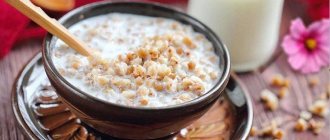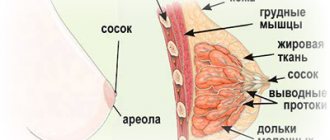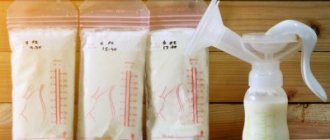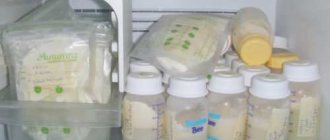Basic composition of breast milk.
The milk that a baby receives at the beginning of feeding is called “foremilk.” It is more liquid than the “back” one, which comes later. Sometimes grandmothers advise a young mother to express milk to check for fat content, and complain that it is blue and empty, which means the baby is starving. They are wrong.
Hind milk comes already during feeding. The child needs to make an effort to get it. A breast pump will not release the breasts as well as the baby does. Moreover, it will not be possible to express milk completely with your hands. Have no doubt - there is exactly as much water in your milk as your baby needs at the moment.
It is important!
Have no doubt - there is exactly as much water in your milk as your baby needs at the moment.
The main components of any food are proteins, fats and carbohydrates. Of course, they are also present in breast milk.
At the end of pregnancy, a woman begins to produce colostrum
. It serves as food for the newborn until real milk comes. With the first drops of colostrum, the baby receives a loading dose of bioactive proteins.
These are proteins that serve not only for nutrition, but also stimulate growth, help absorb vitamins and minerals, protect against pathogens, and form immunity. Then the concentration of these proteins in milk decreases, but they continue to perform their function.
Breast milk protein is unique in composition. 80% of it consists of a serum fraction, similar to blood plasma proteins. This means that such protein is easily and fully absorbed in the baby’s digestive system, unlike cow’s milk, where 80% of the protein is casein. When digested in a child's gastrointestinal tract, casein forms coarse particles. This can cause regurgitation, colic and bowel disorders. Therefore, whole cow's milk is not recommended for children under one year of age.
Another important protein found in breast milk is lactoferrin
.
It promotes iron absorption, kills some harmful bacteria and fungi, and affects growth factor. In cow's milk, lactoferrin is 1%, and in women's milk it is almost 20%. A tenth of the proteins in breast milk are immunoglobulins
- mainly immunoglobulin A, which also protect the body from viruses and pathogenic bacteria. Breast milk contains 30 to 50 g of fat per liter. They are easily absorbed by the newborn’s body and allow him to receive fat-soluble vitamins – A, D, E.
Human milk fat contains polyunsaturated fatty acids - omega-3
,
omega-6
, necessary for brain development and the proper functioning of all body systems.
Carbohydrates in breast milk provide the baby with energy for growth and development. The main carbohydrate in human milk is lactose.
. It not only serves as a source of energy, but also has a beneficial effect on the child’s intestinal microflora. Cow's milk contains only 4% lactose.
Dairy components
Water. GM is 80% water, so when the mother thinks the baby is thirsty, she can give GM. This will quench thirst, protect the child from infection by pathogenic agents and allow him to develop well.
Squirrels. In GM they are of two types - whey protein, which is approximately 60%, and 40% casein. This ratio allows for quick and easy absorption of GM. The higher casein content in some adapted dairy products may make them more difficult for your baby to digest.
About 60-80% of the total protein in breast milk is whey protein. But it also contains other specific elements such as:
Lactoferrin
It inhibits the growth of iron-dependent bacteria in the gastrointestinal tract. This stimulates the proliferation of certain gastrointestinal organisms (such as coliforms and yeast) that require iron for their development.
Immunoglobulin A (IgA)
Helps protect against viral and bacterial infections and possible allergies. In addition to this immunoglobulin, GM also contains others (IgG and IgM) that also have an anti-infective effect. To increase the amount of immunoglobulins in the GM, mothers are advised to eat fish more often.
Fats
GM also contains fats that are essential for baby's health. They are a major basal source of calories and are beneficial for brain development and the absorption of fat-soluble vitamins. Children's nerve cells are covered with a substance called myelin, which helps transmit messages to other nerve cells in the brain and body. To produce high-quality myelin, you need some types of fatty acids - linoleic and linolenic, which are present in the required quantities in GM. Typically, the level of fat at the beginning of the diet is low and then increases. The amount of fat in GM is constantly changing. Longer intervals between meals lead to a decrease in the presence of fat in the GM, which is one of the reasons that a strict 3-4 hour diet is biologically incorrect.
Vitamins and minerals
The amount and type of vitamins and minerals in the GM are directly related to the mother's nutrition. Therefore, it is extremely important that she eats properly and takes the required amount of healthy food, both during pregnancy and lactation. In this regard, advice from doctors and lactation consultants will also be needed. Fat-soluble (A, D, E and K) and water-soluble (C, riboflavin, niacin and pantothenic acid) vitamins are vital to children's health.
Carbohydrates
Lactose is the main carbohydrate in GM. It accounts for approximately 40% of the total calories provided by it. This helps reduce the number of harmful bacteria in the stomach (which improves the absorption of calcium, phosphorus and magnesium), stimulates the formation of beneficial bacteria and fights disease. However, some children have significant problems with lactose tolerance.
Composition of some essential nutritional components present in GM.
What else is in breast milk?
GM also contains important non-nutritional components - antimicrobial factors, digestive enzymes, hormones and growth factors that are important for passive defense against infections and immune-mediated diseases, as well as those that modulate the development of the immune system.
Lysozyme
An enzyme that promotes the growth of intestinal flora, has anti-inflammatory functions and protects the baby from bacteria such as E. coli and salmonella.
Bifidus factor
Promotes the growth of lactobacilli (Lactobacillus). This is a group of beneficial bacteria that protect children from harmful bacteria by creating an acidic environment in which they cannot survive.
Every year, medical publications demonstrate the discovery of new important substances and properties contained in GM. Experts are only at the beginning of studying other GM factors that are potentially important for the maturation of the baby. In particular:
- - enzymes other than lipase;
- — epidermal growth factor is present in GM in significant quantities, promoting the development of gastrointestinal tissues and other areas;
- - hormones in the GM that affect the metabolism, growth and physiology of a small person.
The influences can be both short-term and long-term. Science is at the beginning of research, and we will soon find out what other advantages GM has. At the moment, it is known that with breastfeeding, a child receives more than 700 types of bacteria, GM improves the effect on the DNA of children and strengthens their immunity, scientists have also already shown that GM contains stem cells, which are extremely important for children, especially when their immunity is weaker.
Stem cells
Stem cells were first discovered in breast milk in 2007. The results, presented at the National Breastfeeding Symposium in London in October 2014, show that stem cells in breast milk do play a role in the development of many organs, including the brain, pancreas, liver, spleen and kidneys. Many of them integrate into the body and become functional cells.
Breast milk should be the main source of calories by the end of the first year of life (this means about 75% milk and 25% solids). Iron requirements increase after the first 6–9 months, so it is beneficial to include iron-rich foods in the second half of the first year.
What else is in breast milk?
• Enzymes
– help absorb nutrients and are responsible for metabolic processes in the body.
• Microflora
– beneficial bacteria from the mother’s body populate the child’s intestines and then participate in digestion.
• Immune cells
– form the child’s immunity, that is, his ability to resist diseases.
• Stem cells
– can form any tissue in the body.
• Vitamins
– breast milk contains them in such quantities as to fully satisfy the baby’s needs.
The exception is vitamin D, which is additionally given in dosage form. • Minerals
– participate in the formation of bone tissue and metabolism.
• Hormones
– affect all functions and processes of the body.
This is a simplified list of the components of breast milk. To list all the components and their properties, a voluminous scientific work will be required. But this is enough to understand the main thing: the body of a nursing mother creates ideal nutrition for each specific child. The composition of breast milk adapts to the baby's needs in hot and cold weather, morning and evening, when he is healthy or sick. Isn’t this a miracle that is currently impossible to recreate artificially? Therefore, the World Health Organization encourages mothers to continue breastfeeding for as long as possible - up to two years.
Foremilk and hindmilk
Mother's milk is divided into “front” and “back”. Foremilk consists of 87 percent water, but the water there is not simple, one might say, “golden”. It contains a huge amount of vitamins and important hormones for the child’s body. This water is fully adapted to the child’s stomach, which eliminates the risk of any bad microorganisms that may be in regular water or in adult food getting into the baby’s stomach.
Therefore, there is no need to supplement the child’s drinking until 6 months. Breast milk contains enough water, the most suitable for the baby.
After the baby sucks out the fore milk, the “hind milk” begins. It is very high in calories, saturated with healthy fats, proteins, carbohydrates and growth factors.
And isn’t it amazing that the composition of milk changes from feeding to feeding? Even within one feeding, breast milk varies. It includes several dishes at once, containing “first”, “second” and “compote”.











